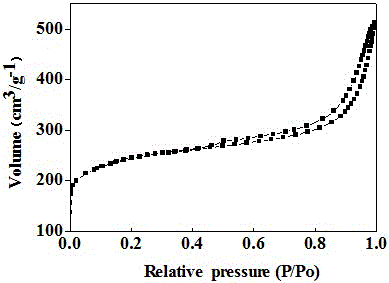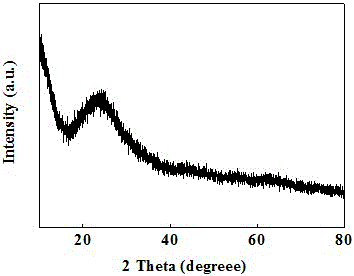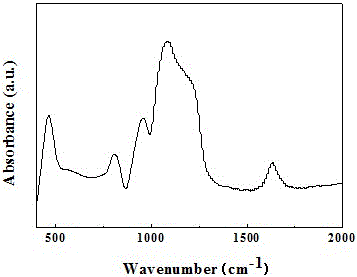Visible-light-driven photocatalyst for degrading dye in wastewater, and preparation and application thereof
A catalyst and visible light technology, applied in the field of photocatalysis, can solve the problems that the active components cannot be fully and efficiently utilized, there is no rigid carrier with a large specific surface, and the catalyst is difficult to separate and recycle, etc., and achieves improved reaction stability, low cost, and ease of use. The effect of regeneration
- Summary
- Abstract
- Description
- Claims
- Application Information
AI Technical Summary
Benefits of technology
Problems solved by technology
Method used
Image
Examples
Embodiment 1
[0036] At room temperature, dissolve 3.1 g of cetyltrimethylammonium bromide in a mixture of 250 ml of ethanol and deionized water (the volume ratio of absolute ethanol and deionized water is 1:4) to obtain solution A After 30 minutes, in solution A, add dropwise 50 ml25% ammoniacal liquor successively, 13 milliliters of tetraethyl orthosilicate and 0.2 milliliters of titanium isopropoxides, continue stirring at room temperature after 4 hours, obtain solid substance B by suction filtration, then solid Substance B was dried at 110°C for 5 hours, calcined at 500°C for 6 hours, and cooled to obtain mesoporous MCM-48 (Ti-MCM-48) solid particles with Ti atoms in the skeleton.
[0037] In 15 ml deionized water, add 0.2 g dicyandiamide, 0.02 g CuCl 2 ·H 2 O and 1 g of the Ti-MCM-48 obtained above were stirred at 100 °C for 2 hours, and the blue solid powder C was obtained by ordinary distillation; then the obtained blue solid powder C was dried at 110 °C for 5 h, and then heated at 550
Embodiment 2
[0044] At room temperature, dissolve 3.1 g of cetyltrimethylammonium bromide in a mixture of 250 ml of ethanol and deionized water (the volume ratio of absolute ethanol and deionized water is 1:4) to obtain solution A After 30 minutes, in solution A, add dropwise 50 ml25% ammoniacal liquor successively, 13 milliliters of ethyl orthosilicate and 0.032 milliliters of titanium isopropoxides, continue to stir at room temperature after 4 hours, get solid substance B by suction filtration, then solid Substance B was dried at 110°C for 5 hours, calcined at 500°C for 6 hours, and cooled to obtain mesoporous MCM-48 (Ti-MCM-48) solid particles with Ti atoms in the skeleton.
[0045] In 15 ml deionized water, add 0.2 g dicyandiamide, 0.02 g CuCl 2 ·H 2 O and 1 g of the Ti-MCM-48 obtained above were stirred at 100 °C for 2 hours, and the blue solid powder C was obtained through ordinary distillation. Then the obtained blue solid powder C was dried at 110 °C for 5 h, calcined at 550 °C for
Embodiment 3
[0048] At room temperature, dissolve 3.1 g of cetyltrimethylammonium bromide in a mixture of 250 ml of ethanol and deionized water (the volume ratio of absolute ethanol and deionized water is 1:4) to obtain solution A After 30 minutes, in solution A, add dropwise 50 ml25% ammoniacal liquor successively, 13 milliliters of ethyl orthosilicate and 0.32 milliliters of titanium isopropoxides, continue to stir at room temperature after 4 hours, get solid substance B by suction filtration, then solid Substance B was dried at 110°C for 5 hours, calcined at 500°C for 6 hours, and cooled to obtain mesoporous MCM-48 (Ti-MCM-48) solid particles with Ti atoms in the skeleton.
[0049] In 15 ml deionized water, add 0.2 g dicyandiamide, 0.02 g CuCl 2 ·H 2 O and 1 g of the Ti-MCM-48 obtained above were stirred at 100 °C for 2 hours, and the blue solid powder C was obtained by ordinary distillation; then the obtained blue solid powder C was dried at 110 °C for 5 h, and then dried at 550 °C under
PUM
 Login to view more
Login to view more Abstract
Description
Claims
Application Information
 Login to view more
Login to view more - R&D Engineer
- R&D Manager
- IP Professional
- Industry Leading Data Capabilities
- Powerful AI technology
- Patent DNA Extraction
Browse by: Latest US Patents, China's latest patents, Technical Efficacy Thesaurus, Application Domain, Technology Topic.
© 2024 PatSnap. All rights reserved.Legal|Privacy policy|Modern Slavery Act Transparency Statement|Sitemap



